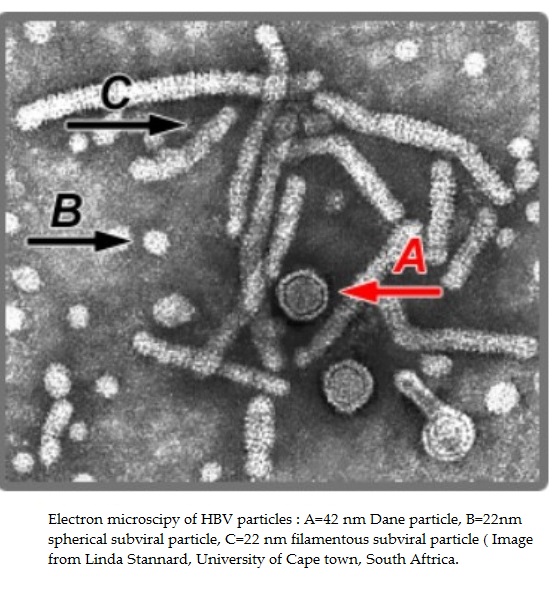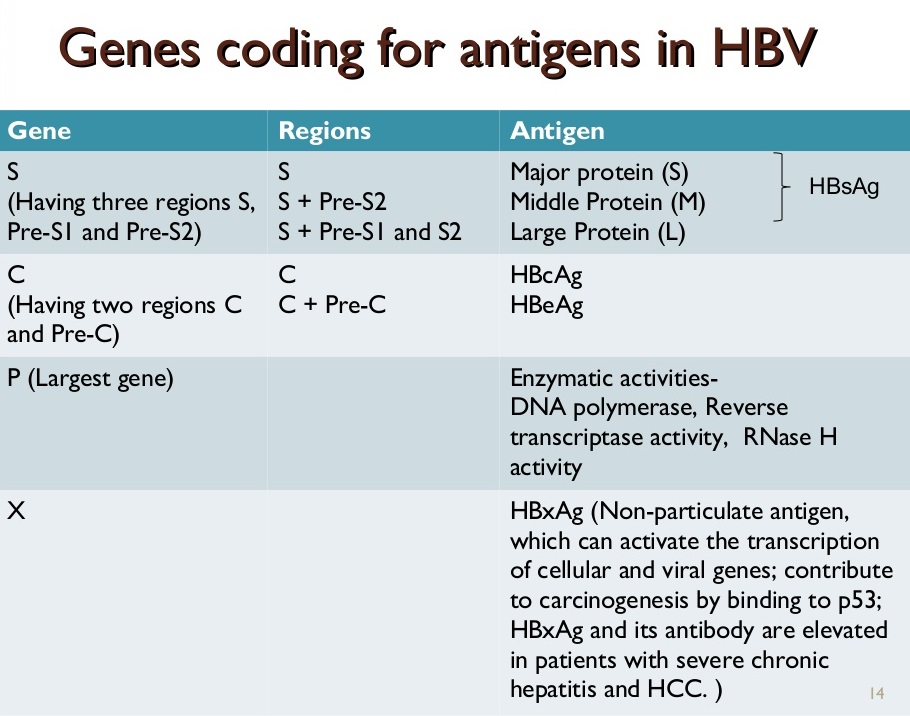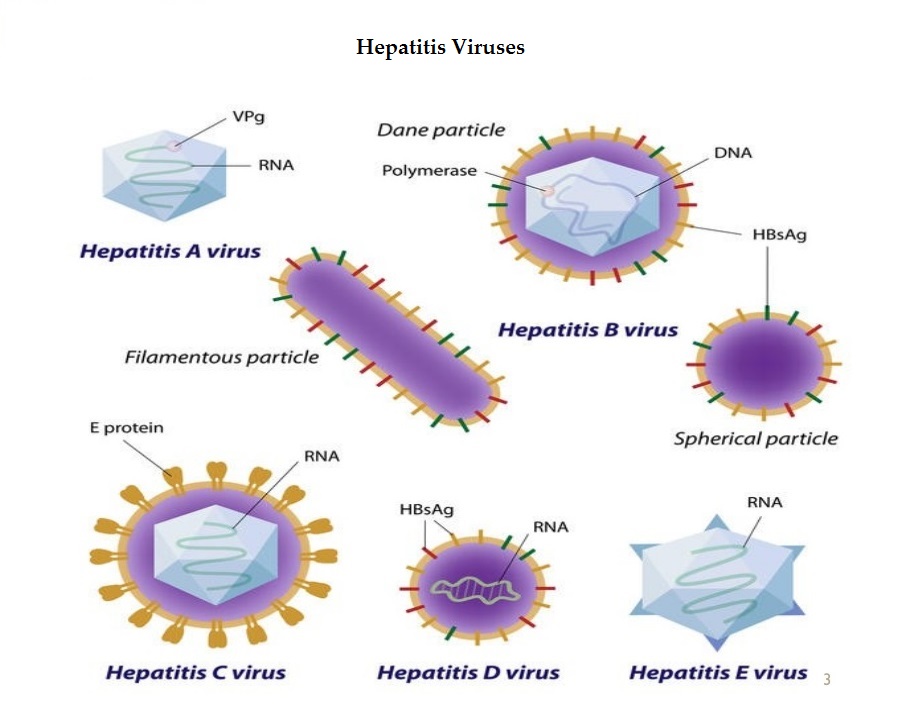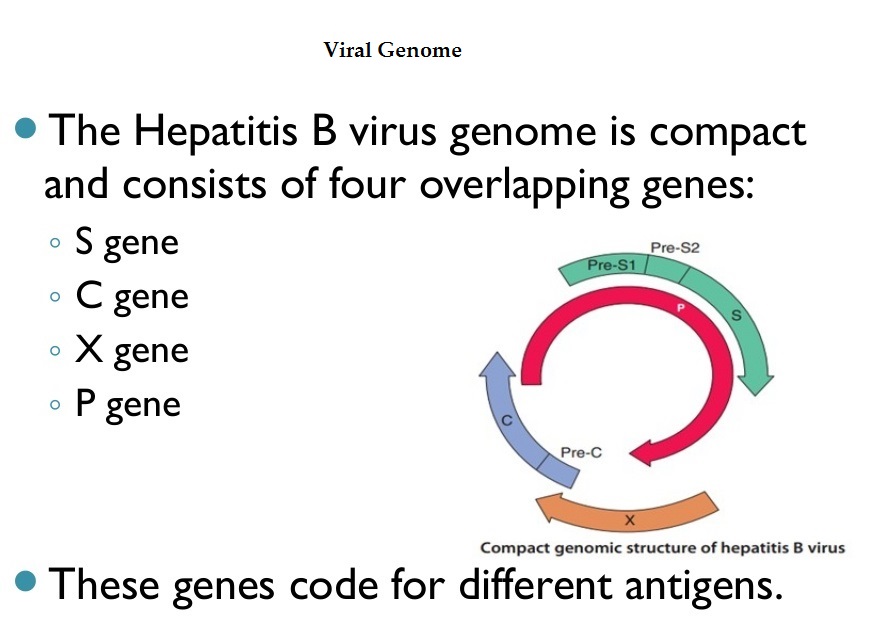Hepatitis B Virus
Viruses that cause hepatitis
Hepatitis virus A, B, C, D, E and G
Coxsackie virus
Yellow fever virus
Adenovirus
Paramyxo virus
Rubella virus
Hepatitis B Virus Morphology
Two forms : Complete form and Subviral Particle
Complete form (or Dane particles)
They represent the intact Hepatitis B virus
Less frequently observed
Double shelled
Spherical lipid-containing structure with and outeer diameter
The outer surface envelope represents surface antigen (NBsAg)
It has three forms of the viral envelope proteins 0 L, M, S
Icosahedral nucleocapsid represents the inner shell of the virus. It consists ofcore antigen (HBcAg), precore antigen (HBeAg) and partially double stranded DNA
Viral genome
consists of two linear strands of DNA held in a circular configuration; one of the strands is incomplete while the other is complete; This gives the apperance of partially double stranded and partially single stranded DNA.; Associated with the plus strand is a viral DNA polymerase.
The viral genom is compact and consists of four overlapping genes:
Sgene - responsible for Antigen HBsAg
C gene - responsible for Antigen HBcAg and Antigen HBeAg
P gene - responsible for Enzymatic activities - DNA polymerase, Reverse transcriptase activity, RNase H activity
x gene - responsible for Antigen HB - responsible for HBxAg - NonParticulate antigen, which can activate the transcription of cellular and viral genes; contibute to carcinogenesis Found in severe chronic hepatitis and HCC
Determining the genotype could be helpful for predicting the outcome of disease, and antivital therapy in patients with chronic hapatitis B.
Clinical significance of Genotyping
Genotype B appears to be associated with less rapidly progressive liver disease and cirrhosis and a lower likelihood, or delayed appearance, of HCC (Hepatocellur Carcinoma) than genotype C or D.
Patients infected by genotype A are more likely to clear circulating viremia and to achieve HBeAg and HBsAg seroconversion, both spontaneously and in response to antiviral therapy. Rate of resistance to lamivudine is higher
Impact of HBV genotypes on response to antiviral therapy
HBV genotypes D and C are associated twith a lower rate of favorable response to interferon alpha therapy than genotypes A and B, respectively.
No difference in the risk of lamivudine resistance in Genotype B and genotype C.
In patients with genotype C infection, however, virological response is worse during lamivudine therapy, and is also less durable after the discontinuation of therapy than in patients with genotype B infection
HBsAg (Australia antigen)
Blumberg et al (1965) - in Australian aborigine - HBsAg contains a group specific antigen,
There are four phenotypes of HBsAg - Adw, ayw, adr, ayr - useful in epidemiologic investigations.
Hepatitis B virus mutants
Precore mutants - They have defect in precore region of C gene which leads to therir inability to synthesize HBeAg - patients may be diagnosed late and they tend to have severe chronic hepaitit that progresses more rapidly to cirrhosis.
Escape mutants - Mutation in the S gene leading to alteration of HBsAg (mutation in the "a" antigen - pose problem in the diagnosis of the disease.
YMDD mutation - patients on lamivudine therapy may develop resistance to the drug due to mutation in the YMDD (tyrosine-methonine-aspartate-aspartate) locus present in the HBV reverse transcriptase region of polymerase gene
Properties of Hepatitis B Virus
HBV and HBsAg - stable at -20° C = stable to repeated freezing amd thawing
HBV (but not HBsAg) is sensitive to higher temperatures (100° C for 1 minute)
Hepatitis B carriers
Simple carrier - HBeAg - - HBsAg + (low titer)
Large volume of blood is required for transmission
Super carrier - HBeAg + - Highly infectious (0.00001 ml of plasma can transmit infection)
Mode of transmission
Entry of the virus into the blood through skin, mucous membrane or body fluids
Main routes of transmission
Blood transfusion, use of HBV contaminatd needles, blades, Sexual intercourse, perinatal
Chance of transmission following a contaminated needle prick injury - HBV 30%, HCV 3%, HIV 0.3%
* * * * * * *
Blood Borne Micro-organisms
Name the blood borne micro-organisms. List the blood borne virus infections. Describe the morphology of hepatitis B, modes of spread, laboratory diagnosis and prevention of hepatitis B infection






